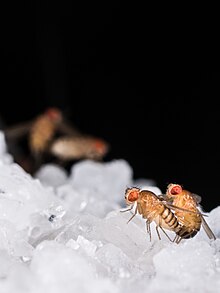Seminal fluid proteins (SFPs) or accessory gland proteins (Acps) are one of the non-sperm components of semen. In many animals with internal fertilization, males transfer a complex cocktail of proteins in their semen to females during copulation. These seminal fluid proteins often have diverse, potent effects on female post-mating phenotypes.[2] SFPs are produced by the male accessory glands.

Seminal fluid proteins frequently show evidence of elevated evolutionary rates and are often cited as an example of sexual conflict.[2]
Proteomics
SFPs are best studied in mammals and insects,[3] especially in the common fruit fly, Drosophila melanogaster. Most species produce a wide variety of proteins that are transferred to females. For example, approximately 150 SFPs have been identified in D. melanogaster,[4][5] 46 in the mosquito Anopheles gambae,[6] and around 160 in humans.[7]
Elevated evolution
Even between closely related species, the seminal fluid proteome can vary greatly. SFPs show elevated rates of DNA sequence change compared to non-reproductive genes (measured by Ka/Ks ratio) in many orders, including Diptera (flies),[8][9] Lepidoptera (butterflies and moths),[1] Rodentia,[10] and Primates.[11][12][13]
Additionally, SFPs show high rates of gene turnover compared to non-reproductive genes.[9]
Function

The function of SFPs is best understood in D. melanogaster. SFPs play a role in male–male sperm competition. One study that manipulated the amount of SFPs male D. melanogaster produced found that when males were in competition, males that produced more SFPs sired a larger proportion of offspring.[14]
In many insect species, significant changes occur in female behavior and physiology following mating; the isolated receipt of SFPs has been shown to be responsible for many of these changes. In D. melanogaster females, over 160 genes show either up or down-regulation following isolated SFP receipt.[15] These transcriptomic changes are not limited to the female's reproductive tract.[16] SFPs lengthen the refractory period (when the female is disinterested in mating) and stimulate ovulation; additionally they can affect processes such as sperm storage, metabolism, and activity levels.[3]
Though SFPs seem to play a role in coordinating male and female reproductive efforts (e.g. in timing of ovulation), SFPs may also be a source of sexual conflict. Studies of D. melanogaster have revealed that females who received SFPs suffered decreased lifespan and fitness.[17] Frequent mating in D. melanogaster is associated with a reduction in female lifespan,[18] and this cost of mating in females has been shown to be primarily mediated by receipt of SFPs.[19]
As SFPs play an important role in reproductive processes in disease-carrying species of mosquito and additionally tend to be highly species-specific, manipulation of SFPs may hold potential for highly targeted control of these mosquito populations.[20]